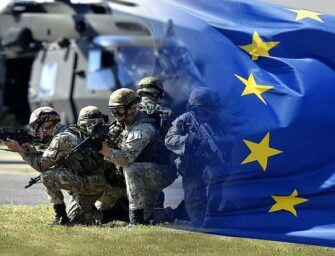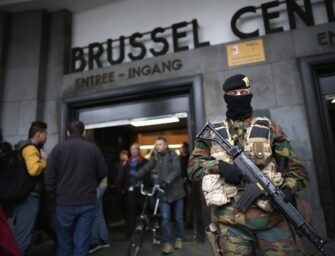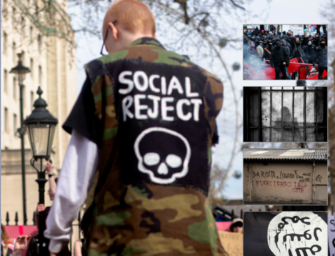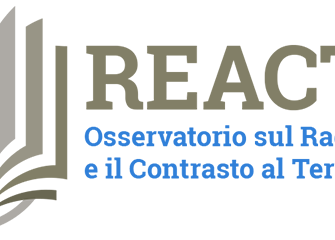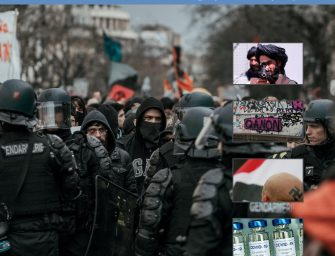#ReaCT2021- Extreme right and extreme left in pandemic times: some reflections
by Barbara Lucini, ITSTIME “Cattolica” University
 The pandemic scenario that emerged with the spread of the Covid-19 epidemic has highlighted some challenges, which many companies will face in the coming years.
The pandemic scenario that emerged with the spread of the Covid-19 epidemic has highlighted some challenges, which many companies will face in the coming years.
The new types of extremism that took shape in the immediate weeks following the onset of the pandemic are one of them. In fact, like any crisis, the health pandemic crisis has had an impact on terrorist organisations and extremist movements.
The first considerations that can be made in this field, focus on some emerging and typical characteristics of left and right extremism, which seem increasingly to have common trends in the use of skills, methodologies and communication strategies spread both online and in real life.
First of all, the paradox present in the increasingly international vocation, which promotes the prospect of an organizational network, animated by the crossing of geographical boundaries to unite dissimilar currents of thought and action: this internationalization, however, implies for both the extreme right and left orientations, a strong roots on the territory of origin, which increasingly assumes the cultural signature of these extremist groups. An example for everyone, the far-right PEGIDA group in Germany, which was born in Dresden and which could not be eradicated from that city and from that socio-cultural context.
This group is also interesting because it highlights another characteristic of extremist groups at the time of the pandemic: the transfer of their thought dissemination, recruitment and funding activities, mainly online. In fact, it was precisely for the PEGIDA group, which organized marches on a Youtube channel during the lockdown in Germany.
New methodologies and different uses of the network are now increasingly appearing to be a systematic trend for both extremist orientations.
Another aspect to note, which has affected national and international far-right groups, is the promotion of disinformation and fake news on issues related to the pandemic. This mode of action is a new form of communicative extremism, which has the aim of producing even more chaos and uncertainty generated by the pandemic crisis, reinforcing the dominant thinking orientation of the extremist group of reference.
In this regard, the various conspiracy theories have been fertile ground, for the use of this methodology by some extreme right-wing movements, already in place with the Cambridge Analytica scandal.
In Italy, the situation regarding right-wing and left-wing extremism is similar to that of other European countries, while preserving some cultural specificities.
Comparing forms of the extreme right and left in Italy at the time of the pandemic it is possible to argue that a competition is taking place, which concerns their survival in a national framework changed by the pandemic; the demands made between the two orientations of some anti-lockdown protests demonstrate a reorganisation in place and, above all, the new heterogeneous structure of the future threat, which will see more and more mixed and varied cultural extremist forms compete or ally, with the aim of provoking social disorder and institutional crises.
In this context, it becomes essential to rethink from a theoretical perspective ideological definitions, which no longer satisfy as in the past the classification of extremism and terrorism of right and left and finally develop methodologies of study and analysis suitable for the consideration of socio-cultural aspects, often underestimated, expressed by the various forms of extremism especially in online environments.
Report #ReaCT2021 – Director’s note: terrorism in the time of Covid-19
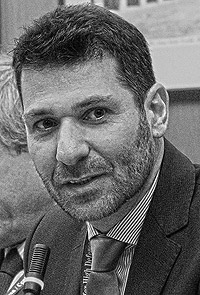 In my role as Executive Director of the ReaCT Observatory, I am honoured to introduce #ReaCT2021, the 2nd Report on Radicalisation and Counter-Terrorism in Europe.
In my role as Executive Director of the ReaCT Observatory, I am honoured to introduce #ReaCT2021, the 2nd Report on Radicalisation and Counter-Terrorism in Europe.
This report offers a concise analysis on the evolution of radical ideologies and terrorist threats in accordance with the European Union directive 2017/541 on the fight against terrorism and is meant as a useful contribution, within the wider public debate, to the harmonisation of member States’ discrepancies around what should be defined and treated as terrorism.
The Observatory mainly focuses on jihadism; however, we make sure to afford enough room and support for studies on other forms of terrorism, ideological radicalisation and social deviance, as well as “conspiracy theories” leading to violent outcomes.
In their assessments, the authors who submitted their work for this issue of #ReaCT2021 took into account the repercussions of new social and conflict dynamics brought about by COVID-19.
Due to other priorities, the pandemic seemed to have sidelined terrorism when, all of a sudden, October 2020 revived the threat which had apparently been overcome. From early September to early November, a successive chain of events clearly highlighted a dramatic and articulated scenario. Those sixty days of fear tell us that terrorism is now a “normal” rather than an ‘exceptional’ phenomenon, as an instrument of the ongoing conflict.
2019-2020: the evolution of European jihadist terrorism
In 2019 according to Europol there were 119 successful, failed or thwarted attacks: 56 of these were carried out by ethno-nationalist and separatist groups; 26 by extreme left radical and anarchist groups; 6 by far right groups; 24 were jihadist, of which 3 were successful and 4 unsuccessful. In the same year, START InSight’s database listed 19 jihadist actions / events (as compared to the 7 reported by Europol); in 2020, the number goes up to 25.
In 2019, jihadists were responsible for all deaths from terrorism in Europe: according to Europol, 10 people lost their lives and 26 were injured (1 person was injured in a far-right attack). START InSight recorded a higher number of people with injuries (48), who were mostly victims of marginal and emulative attacks. In 2020 there was a significant increase in deaths: 16 people were killed and 55 were injured.
The long wave of terrorism which hit Europe following the emergence of the “Islamic State” phenomenon recorded 146 jihadist attacks from 2014 to 2020: 188 terrorists took part in these attacks (59 among them died in action); 406 people lost their lives; 2,421 were injured (START InSight’s database).
Cases of recidivism are on the rise: 3 out of 10 in 2020. START InSight also spotted an increase in actions carried out by terrorists already known to European police forces or intelligence services: 54% of the total in 2020.
An increase in the number of irregular migrants heightens the potential risk of terrorism: 20% of terrorists are irregular immigrants. In France, the number of irregular immigrants involved in terrorist attacks is growing. Until 2017, no attack had seen the participation of irregular immigrants; in 2018, 15% of terrorists were irregular immigrants: in 2020, they reached 40%.
Islamic State and al-Qaeda online terrorist propaganda during the Covid-19 emergency
Propaganda activities carried out during the Covid-19 pandemic and the attacks which took place in Paris, Nice and Vienna, recall how dynamic terrorism associated with the Islamic State and al-Qaeda remains, especially through the Internet. In particular, the Islamic State confirmed its aggressive narrative, identifying the Coronavirus as a “soldier of Allah”. An ally, set out to punish the “infidels”, above all the military and police forces.
The concepts and importance of preventing and countering violent extremism (PVE/CVE)
PVE and CVE gradually became an integral part of the global counter-terrorism architecture. In order to be long-term and effective, these policies and projects require a constant dialogue among researchers, practitioners, law enforcement agencies and legislators which also sets out priorities and expectations. Measuring the results of these activities remains a difficult task but several European think tanks are already bent on the issue.
Countering radicalisation and terrorism via criminal law: problems and perspectives
By its very nature, counterterrorism criminal law does not affect the causes of radicalisation and terrorism. An overarching and disproportionate resort to criminal law may even produce crime-inducing side effects: radicalisation shall be addressed as a reversible process. Counterterrorism criminal law in Europe is generally prison-based, even with regard to facts that arguably do not harm legal goods or interests.
The terror threat in the UK. The challenge: identify, define, arrest and convict
The complexity of the terror threat picture faced by the UK was recently highlighted through court cases which have frustrated the efforts of the security and intelligence forces. The cases that are now emerging are so disconnected from terrorist networks, are planning such random acts and the tools of terrorism are becoming so banal that it has become almost impossible to entirely shield yourself from the threat. But it has also become almost impossible to prove who might be going in this direction. This is creating a new generation of radicals that authorities struggle to identify, define, arrest and convict.
A look at the Balkan gate to Europe
The attack which took place in Vienna in November 2020 drew attention to the issue of terrorism in Europe, especially in the Balkan Area. It also focused such attention on jihadist presence in the Balkan countries, which could become a potential logistical hub for jihadism towards Europe.
Lessons learned from Kosovo’s experience in repatriating former foreign fighters: the small Western Balkan nation of Kosovo repatriated 110 citizens, including men, women, and children, in April 2019, making it one of a very small number of countries that has actively repatriated citizens involved with the Islamic State. The paper also includes what lessons can be learned by EU countries in handling the complex issue of how to manage the return of foreign fighters and their families.
The other terrorisms: far-right, extreme left and the new QAnon phenomenon in pandemic times
The pandemic caused by the Covid-19 virus has also had significant effects on the relational and communicative strategies and methodologies typical of both far-right and extreme left-wing environments. Right-wing violent extremism, a phenomenon in expansion in the West, appears to be acquiring a transnational character and has an emerging symbiotic, mutually-reinforcing interdependent relationship with Islamist extremism. This interdependence poses additional threats to European security.
A threat to democracy is QAnon, a conspiracy theory movement active in more than 70 countries and that presents a high risk of radicalization in Europe. It should be closely monitored because of its potential for violent actions.
Thanks to all of the authors who contributed to this Report. My gratitude also goes to the two co-editors who have given their fundamental input: Chiara Sulmoni, President of START InSight, and Flavia Giacobbe, Director of Airpress and Formiche.
Claudio Bertolotti – Executive Director
FULL REPORT AVAILABLE HERE (ITA/ENG LANGUAGE)
REPORT INDEX
#ReaCT2021 – Terrorism and immigration: links and challenges
by Claudio Bertolotti
Terrorism and immigration: links and challenges
 89% of terror attacks in Europe were carried out by second and third generation “immigrants” and first generation immigrants, both regular and irregular. A statistical correlation between immigration and terrorism does therefore exist; however, the number of terrorists compared to the total number of immigrants is so marginal that it makes such correlation insignificant: the order of measurement is one unit per million immigrants.
89% of terror attacks in Europe were carried out by second and third generation “immigrants” and first generation immigrants, both regular and irregular. A statistical correlation between immigration and terrorism does therefore exist; however, the number of terrorists compared to the total number of immigrants is so marginal that it makes such correlation insignificant: the order of measurement is one unit per million immigrants.
The origins of terrorists: immigrants or Europeans?
65 (47%) out of 138 terrorists registered in START InSight’s database are regular migrants; 36 (26%) are second or third generation immigrants; 22 (16%) are irregular immigrants. The latter figure is on the rise and represents 25% of perpetrators in 2020. Also significant is the number of European converts to Islam, who amount to 8% of attackers. Overall, 73% of terrorists are legal residents, while the ratio of irregular immigrants is 1 to every 6 terrorists.
Is there a link between immigration and terrorism?
Immigration does “contribute” to the spread of terrorism from one country to another, but immigration per se is unlikely to be a direct cause of terrorism. There’s no empirical evidence so far that first generation immigrants are more inclined to become terrorists. However, migratory flows from Muslim majority countries where terrorism is an occurrence, are thought to exercise a significant influence on attacks in the country of destination.
Are immigrants terrorists?
 It’s difficult to argue the existence of a causal link between the two phenomena: therefore, being a migrant would not be a triggering factor for joining terrorism.
It’s difficult to argue the existence of a causal link between the two phenomena: therefore, being a migrant would not be a triggering factor for joining terrorism.
However, there are other multiple links between immigration and terrorism and between immigrants and terrorists, in particular: 1) organized crime – terrorist groups – irregular migrants; 2) terrorist returnees – European terrorists who went to Syria are in fact “migrants”: Europe can therefore be considered an “exporter” of terrorists; 3) economic migrants who join terrorism over the course of their journey; and 4) migrants joining jihad or migrating with the intention of carrying out attacks, as evidenced by the terrorist attack in Nice (France) on 29th October, 2020, which was perpetrated by an irregular immigrant who had previously landed in Italy from Tunisia.
Ethno-national map of terrorism in Europe
Jihadist radicalization fuelling terrorism in Europe affects some specific national / ethnic groups. There is a proportional relation between major immigrant groups and terrorists. The terrorists’ nationalities, or their families of origin, are in line with the dimensions of foreign communities in Europe. Maghrebi origins prevail: the ethno-national groups which are mostly afflicted by a link to terrorism are the Moroccan (in France, Belgium, Spain and Italy) and Algerian (in France).
An increase in the number of irregular migrants heightens the potential risk of terrorism
16% of terrorists are irregular immigrants (2014-2020). 25% in 2020.
In France, the number of irregular immigrants involved in terrorist attacks is growing. Until 2017, no attack had seen the participation of irregular immigrants; in 2018, 15% of terrorists were irregular immigrants: in 2020, they reached 33%. Belgium reported that during 2019 they identified asylum seekers linked to radicalism or terrorism (Europol).
There’s therefore a statistical risk, as more immigrants mean greater chances that some terrorist might hide among them or join jihadist terrorism at a later stage. But despite this correlation, there is no manifest causal link: the choice of becoming a terrorist is not determined or influenced by one’s status as a migrant, but a series of factors such as individual experiences; living conditions at the time of arrival; voluntary or involuntary contacts with criminal or jihadist networks can all play a role.
#ReaCT2021: 2nd Report on Radicalization and Counter-Terrorism
 In my role as Executive Director of the ReaCT Observatory, I am honoured to introduce #ReaCT2021, the 2nd Report on Radicalisation and Counter-Terrorism in Europe.
In my role as Executive Director of the ReaCT Observatory, I am honoured to introduce #ReaCT2021, the 2nd Report on Radicalisation and Counter-Terrorism in Europe.
This report offers a concise analysis on the evolution of radical ideologies and terrorist threats in accordance with the European Union directive 2017/541 on the fight against terrorism and is meant as a useful contribution, within the wider public debate, to the harmonisation of member States’ discrepancies around what should be defined and treated as terrorism.
The Observatory mainly focuses on jihadism; however, we make sure to afford enough room and support for studies on other forms of terrorism, ideological radicalisation and social deviance, as well as “conspiracy theories” leading to violent outcomes.
In their assessments, the authors who submitted their work for this issue of #ReaCT2021 took into account the repercussions of new social and conflict dynamics brought about by COVID-19.
Due to other priorities, the pandemic seemed to have sidelined terrorism when, all of a sudden, October 2020 revived the threat which had apparently been overcome. From early September to early November, a successive chain of events clearly highlighted a dramatic and articulated scenario. Those sixty days of fear tell us that terrorism is now a “normal” rather than an ‘exceptional’ phenomenon, as an instrument of the ongoing conflict.
2019-2020: the evolution of European jihadist terrorism
In 2019 according to Europol there were 119 successful, failed or thwarted attacks: 56 of these were carried out by ethno-nationalist and separatist groups; 26 by extreme left radical and anarchist groups; 6 by far right groups; 24 were jihadist, of which 3 were successful and 4 unsuccessful. In the same year, START InSight’s database listed 19 jihadist actions / events (as compared to the 7 reported by Europol); in 2020, the number goes up to 25.
In 2019, jihadists were responsible for all deaths from terrorism in Europe: according to Europol, 10 people lost their lives and 26 were injured (1 person was injured in a far-right attack). START InSight recorded a higher number of people with injuries (48), who were mostly victims of marginal and emulative attacks. In 2020 there was a significant increase in deaths: 16 people were killed and 55 were injured.
The long wave of terrorism which hit Europe following the emergence of the “Islamic State” phenomenon recorded 146 jihadist attacks from 2014 to 2020: 188 terrorists took part in these attacks (59 among them died in action); 406 people lost their lives; 2,421 were injured (START InSight’s database).
Cases of recidivism are on the rise: 3 out of 10 in 2020. START InSight also spotted an increase in actions carried out by terrorists already known to European police forces or intelligence services: 54% of the total in 2020.
An increase in the number of irregular migrants heightens the potential risk of terrorism: 20% of terrorists are irregular immigrants. In France, the number of irregular immigrants involved in terrorist attacks is growing. Until 2017, no attack had seen the participation of irregular immigrants; in 2018, 15% of terrorists were irregular immigrants: in 2020, they reached 40%.
Islamic State and al-Qaeda online terrorist propaganda during the Covid-19 emergency
Propaganda activities carried out during the Covid-19 pandemic and the attacks which took place in Paris, Nice and Vienna, recall how dynamic terrorism associated with the Islamic State and al-Qaeda remains, especially through the Internet. In particular, the Islamic State confirmed its aggressive narrative, identifying the Coronavirus as a “soldier of Allah”. An ally, set out to punish the “infidels”, above all the military and police forces.
The concepts and importance of preventing and countering violent extremism (PVE/CVE)
PVE and CVE gradually became an integral part of the global counter-terrorism architecture. In order to be long-term and effective, these policies and projects require a constant dialogue among researchers, practitioners, law enforcement agencies and legislators which also sets out priorities and expectations. Measuring the results of these activities remains a difficult task but several European think tanks are already bent on the issue.
Countering radicalisation and terrorism via criminal law: problems and perspectives
By its very nature, counterterrorism criminal law does not affect the causes of radicalisation and terrorism. An overarching and disproportionate resort to criminal law may even produce crime-inducing side effects: radicalisation shall be addressed as a reversible process. Counterterrorism criminal law in Europe is generally prison-based, even with regard to facts that arguably do not harm legal goods or interests.
The terror threat in the UK. The challenge: identify, define, arrest and convict
The complexity of the terror threat picture faced by the UK was recently highlighted through court cases which have frustrated the efforts of the security and intelligence forces. The cases that are now emerging are so disconnected from terrorist networks, are planning such random acts and the tools of terrorism are becoming so banal that it has become almost impossible to entirely shield yourself from the threat. But it has also become almost impossible to prove who might be going in this direction. This is creating a new generation of radicals that authorities struggle to identify, define, arrest and convict.
A look at the Balkan gate to Europe
The attack which took place in Vienna in November 2020 drew attention to the issue of terrorism in Europe, especially in the Balkan Area. It also focused such attention on jihadist presence in the Balkan countries, which could become a potential logistical hub for jihadism towards Europe.
Lessons learned from Kosovo’s experience in repatriating former foreign fighters: the small Western Balkan nation of Kosovo repatriated 110 citizens, including men, women, and children, in April 2019, making it one of a very small number of countries that has actively repatriated citizens involved with the Islamic State. The paper also includes what lessons can be learned by EU countries in handling the complex issue of how to manage the return of foreign fighters and their families.
The other terrorisms: far-right, extreme left and the new QAnon phenomenon in pandemic times
The pandemic caused by the Covid-19 virus has also had significant effects on the relational and communicative strategies and methodologies typical of both far-right and extreme left-wing environments. Right-wing violent extremism, a phenomenon in expansion in the West, appears to be acquiring a transnational character and has an emerging symbiotic, mutually-reinforcing interdependent relationship with Islamist extremism. This interdependence poses additional threats to European security.
A threat to democracy is QAnon, a conspiracy theory movement active in more than 70 countries and that presents a high risk of radicalization in Europe. It should be closely monitored because of its potential for violent actions.
Thanks to all of the authors who contributed to this Report. My gratitude also goes to the two co-editors who have given their fundamental input: Chiara Sulmoni, President of START InSight, and Flavia Giacobbe, Director of Airpress and Formiche.
Claudio Bertolotti – Executive Director
REPORT INDEX
FULL REPORT AVAILABLE HERE (ITA/ENG LANGUAGE)
 The pandemic scenario that emerged with the spread of the Covid-19 epidemic has highlighted some challenges, which many companies will face in the coming years.
The pandemic scenario that emerged with the spread of the Covid-19 epidemic has highlighted some challenges, which many companies will face in the coming years.

 In my role as Executive Director of the ReaCT Observatory, I am honoured to introduce #ReaCT2021,
In my role as Executive Director of the ReaCT Observatory, I am honoured to introduce #ReaCT2021,  89% of terror attacks in Europe were carried out by second and third generation “immigrants” and first generation immigrants, both regular and irregular. A statistical correlation between immigration and terrorism does therefore exist; however, the number of terrorists compared to the total number of immigrants is so marginal that it makes such correlation insignificant: the order of measurement is one unit per million immigrants.
89% of terror attacks in Europe were carried out by second and third generation “immigrants” and first generation immigrants, both regular and irregular. A statistical correlation between immigration and terrorism does therefore exist; however, the number of terrorists compared to the total number of immigrants is so marginal that it makes such correlation insignificant: the order of measurement is one unit per million immigrants.









